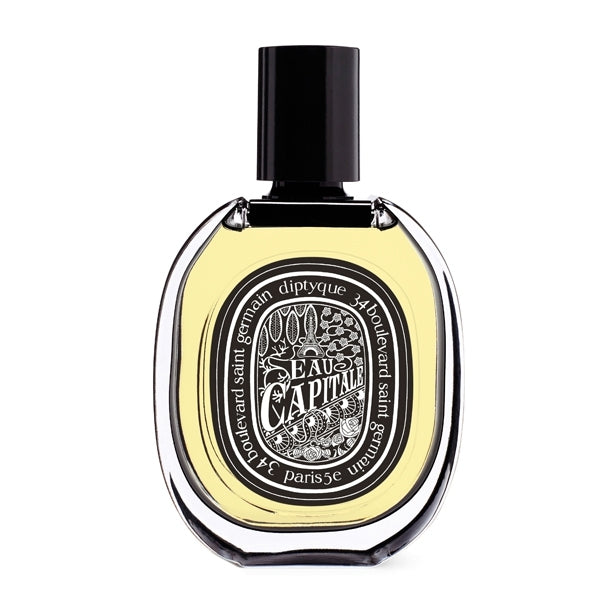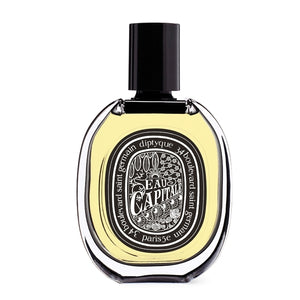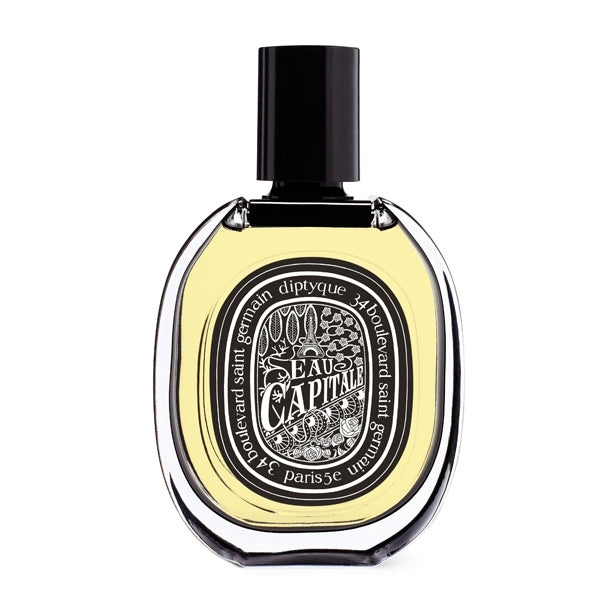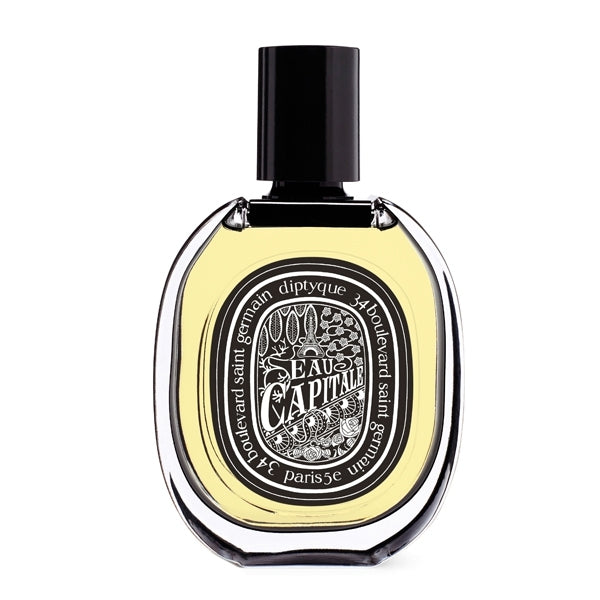Eau Capitale is therefore diptyque's first chypre fragrance, reviving a concept that was conceived over a century ago. Olivier Pescheux, a renowned perfumer and loyal companion of the brand, has taken great care to reinterpret it for the 21st century. An ‘abstract’, enigmatic perfume, it embodies the slightly aloof elegance associated with the ‘City of Lights’ and Parisian flair. The fragrance opens with the ‘green of bergamot’, whose freshness rounds off the prevailing sensuality: naturally fruity, but very lively and tangy, full of citrus juiciness. Were pink berries added to recall the pomanders (oranges studded with cloves) that Desmond brought back from England? Or to orchestrate the eagerly awaited ‘olfactory coincidence’? Between the flower and the spice stands an exclamation mark, capital and worthy of a capital city.
At the centre of the triangle is a bouquet of flowers, excessive in its opulence. The petals are wide open, just before wilting, giving off an intense, ‘candied’ scent of Bulgarian and Turkish rose and ylang-ylang from the Comoros. François Coty undoubtedly used the Grasse variety of Centifolia (also known as May rose) at the time.
Unfortunately, it has almost disappeared today, but botanists have managed to replace it with particularly delicate cultivars planted in Eastern Europe. Even the residual water from its distillation, which is also used in Eau Capitale, still exudes a divine fragrance. Ylang-ylang, on the other hand, with its sensual sweetness, is reminiscent of English sweets that you can never get enough of. A long-lasting fragrance that proves to be a faithful companion. An essence of cinnamon bark provides the woody notes that follow. Finally, the perfumer takes the liberty of using patchouli instead of lichen, moss, oak or pine. Its leaves are harvested and distilled in Indonesia, in accordance with all ethical principles of sustainable development. Spiced with a facet of ‘Akigalawood’, which is created by an enzymatic reaction of the plant through contact with bacteria. Finally, a hint of ‘Georgywood’ brings out the earthy and dark aspects of vetiver. Rounded off by Ambrofix, with notes of musk, tobacco and grey ambergris...
See well to smell (even) better
The diptyque saga began with brushes, pencils, paints and paper. And canvases. Long before fragrances, the brand's founders were united above all by art: Yves, a former student of the École du Louvre, Desmond, who had studied fine arts, and Christiane, a graduate of the Arts Décoratifs. The first became a stage designer, while the other two were already designing furniture fabrics together. They painted constantly. With this knowledge, it becomes clear how important the visual aspect was in the conception of their perfumes, and still is today – because they all tell a story. Each of the three friends had their own area of responsibility within their partnership – Yves was the director, Christiane the artist with fairy fingers, Desmond the natural inspirer. The latter was responsible for designing labels, cardboard boxes and signatures.
With his ink strokes, he set black against white, sometimes twisted, sometimes symmetrical. His writing was integrated into the iconic oval: his logo, recognisable among thousands. The trio is no longer with us, but their spirit lives on. Each new creation offers an opportunity to remember them. To design the bottle for Eau Capitale, diptyque commissioned Pierre Marie, an ornamentalist (as he calls himself) and long-time collaborator of the house. His exuberant images, strongly inspired by the Modern Style and English Art Nouveau, read like a novel: from the front to the back of the bottle, from the outside to the inside, as if you were turning the pages to find out more.
The birth of chypre
If you look closely, there are – apart from the aforementioned bathroom – a surprising number of other connections between diptyque and this brief period around the turn of the century: the swan, then a symbol of feminine grace, has long been present in the brand's iconography and shapes the identity of l'Ombre dans l'Eau. The same applies to the peacock with its incomparable plumage, another symbolic bird of the Belle Époque, which has appeared on the panoramic illustration of the l'Eau perfume since 1968. Orientalism was a true passion of the founders Desmond Knox-Leet, Christiane Gautrot and Yves Coueslant. English painters and graphic artists such as Arthur Rackham, Aubrey Beardsley and William Morris inspired Desmond with their indescribably beautiful, stylised book illustrations for the design templates for the vignettes that would adorn the bottles in future. At the same time, the art of perfumery was reinventing itself through the use of chemical fragrances and entering the modern era. Joseph Marie François Spoturno, better known by his alias François Coty, is considered the founder of this development. What remains of his work? In terms of material, virtually nothing: a few metal containers in a safe in the fragrance archive, the Osmothèque in Versailles. Culturally, however, it laid the foundation for what was considered the pinnacle of ‘Parisian chic’ for decades and became the most famous fragrance structure in the history of perfume: chypre.
The story behind it: Chypre is a fragrance architecture that results from the boiling points and respective evaporation rates of the raw materials used. Chypre: First, citrus or green notes such as bergamot and verbena flash for 5 to 30 minutes. Floral, spicy or fruity notes such as rose and jasmine then take over and carry the fragrance for one to several hours... What remains are woody and root accents, gum resin and absolutes, which sometimes linger for a whole day: patchouli and oak moss. The whole thing takes the form of a pyramid, from the top to the base: top, heart, base.




